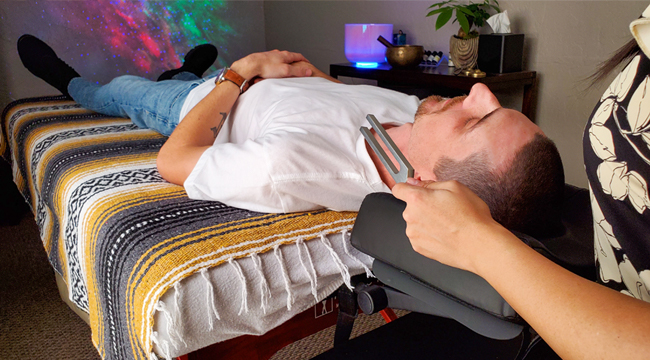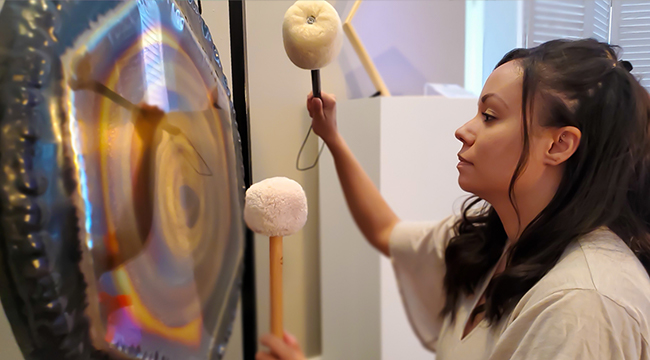Sound Therapy
Sound therapy, also referred to as vibrational therapy can feel “out there” and too new age. But there is science to back up the benefits of sound Therapy. Everything in the universe has a vibrational frequency. Sound is hard-wired to be a part of us. In the brain, all our neurons fire at different frequencies based on the data they receive from things around us. Those vibrations interact with every cell in our body. By entering a parasympathetic state of deep relaxation and meditation allows us to detach from the physical world, which can help us process and begin the healing of unresolved mental, emotional and even physical trauma. In doing this, we clear the mind and find a renewed sense of purpose, well-being, calm, and happiness.
Sound therapy offers more than just mental benefits. We can use different sound frequencies to interact with our brainwaves and promote physical healing. The specific rhythms and frequencies used by sound therapy instruments can modulate your brain from the beta state (normal waking consciousness) to the theta state (relaxed consciousness, light sleep) and even the delta state which is dominate when you’re in a period of deep, restorative sleep. There are also multiple stages for each state. We won’t go into these stages, but a quick search of the subject should yield plenty of great results.
In the Theta and Delta state we decrease our awareness of the physical world and access information in our unconscious mind. This is where most of the healing occurs. In this state the brain can attend to other issues within the body. If there are areas that need to heal, the brain can trigger the release of hormones that encourage tissue growth and repair blood vessels. This helps wounds to heal faster but can also restore sore or damaged muscles.
How Does Sound Therapy Work?
The sound waves or vibrations created by the practitioner's tools, like gongs, tuning forks, and singing bowls, can alter your brainwave frequencies, measured in units of hertz (Hz). Vibration is also measured in hertz, the same unit in which we measure sound. We as humans hear a range of frequencies from 20 Hz up to 20,000 Hz, but this doesn't mean frequencies outside this range don't affect us. When you have two vibrating entities next to each other, the stronger vibration will affect the weaker one, and eventually, they'll synchronize. This synchronization is a property of basic physics.
Then there's basic anatomy. In your ear, the posterior wall of the external audio canal, the lower part of the eardrum’s membrane and in the middle ear is connected to the vagus nerve which is the major parasympathetic nerve in your body. It travels all the way down to the lower internal organs and is responsible for a high number of regulatory functions in the body. The parasympathetic nervous system helps control hormone release, digestion, blood glucose levels, inflammation, heart rate, and blood pressure. This allows a reduction in stress, both mentally and physically.
A little branch of the vagus nerve goes right to the tympanic membrane, which vibrates in response to sound waves. So that means that every sound that you process through your ears sends that information to the vagus nerve. You may be asking yourself why this matters. An inactive or blocked vagus nerve is not good for your health. Stimulating it with the right frequencies can bring your body and mind back to balance.
What Does Science Say?
Research suggests that sound therapy instruments such as tuning forks – a two-pronged steel device vibrates at a specific pitch when struck and placed at certain points of the body may help relieve muscle and bone pain. A study from 2016 found that mediating while listening to singing bowls, improve breathing and circulation, strengthen the immune system, and alleviate aches and pains. Another recent study found that vibroacoustic therapy can penetrate on a cellular level when these vibrations and sounds are placed directly to the body and could be an effective complimentary treatment for chronic pain and injury recovery.
While the process behind these benefits is still being researched, there is no doubt that sound therapy does put your body in a parasympathetic state. When you are in the opposite sympathetic state (fight or flight), generated from stress or pain, your body surges with cortisol and inflammatory molecules which is not healthy for the body.
By using different sound frequencies can open up blood vessels, help cells be more efficient and regulates your blood pressure at a cellular level.
What You Need to Know
It can be hard to cut through the hype of sound therapy right now since the science hasn't quite caught up with people's hopes. But the beauty of these treatments is that they're not invasive which means there's no danger in giving it a try if you're interested. One-one-one sound therapy treatments are offered at Bee Humble Wellness with Nicole Cooper.
Sound Therapy works best as a complementary treatment to conventional medicines you may have as part of your lifestyle. But you don't need science to back up the idea that surrounding yourself with good vibrations—whether that means people you like or sounds that make you feel good—makes you feel better.
Schedule




